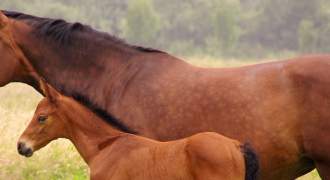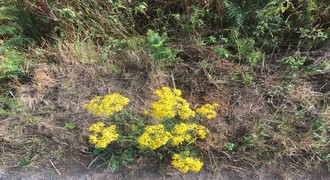
Summer weight watching tips
Grass is the most natural feed for horses and our equine friends usually love nothing more than mooching about in the field with t...
29 June 2020
Read More
Grass is the most natural feed for horses and our equine friends usually love nothing more than mooching about in the field with their herd, gorging on their favourite green stuff and dozing in the sun. But during the seasons when the grass is growing continuously – when the soil temperature consistently reaches 5 degrees or more – grass can be very calorific. Horses can gain weight rapidly, increasing their risk of obesity-related diseases such as laminitis. It’s up to us as their owners or carers to manage their weight and keep them healthy.
Restricting grass intake
Research has shown that horses are capable of eating 24 hours-worth of grass in just four hours so if you need to manage your horse’s weight this summer a good start point is to cut back on grass.1
There is no ‘one size fits all’ solution because every horse is different, not all yards are the same and owners have different routines. Luckily there are various ways to restrict grass, enabling you to choose the most suitable option for your horse and your circumstances.
Strip grazing
The latest research conducted in collaboration with SPILLERS via the WALTHAM Equine Studies Group shows that strip grazing could be a useful tool for restricting weight gain. Ponies with gradual access to pasture via strip grazing had significantly lower bodyweight gains than their counterparts who were allowed free access to the entire 28-day herbage allocation. Based on this work it’s certainly worth considering installing a strip system.2
Grazing muzzle
Opting for a grazing muzzle can suit some horse and management regimes but muzzles need to be fitted properly and your horse needs to be comfortable wearing one before being left alone. Ideally a muzzle shouldn’t be worn for 24 hours at a time. It’s best to give your horse a muzzle-free rest in the stable though because recent research has shown that horses are likely to binge eat if the muzzle is removed in the field and this can increase the risk of laminitis.1,2
Track system
Installing a track system can increase exercise and enrichment, keeping your horse occupied despite there being less for him to eat! The system usually involves building a track around the outside of the paddock to encourage the horse to move and forage more. Depending on the paddock available, different terrains can be included in the track such as woodland, bushes and hills. Logs, mats and scratching posts can add variety and interest too.3
Sharing grazing
Rotating paddocks according to different dietary needs can be useful; horses with lower body condition scores can crop the grass before the weight watchers have their turn in the paddock. Alternatively, you could consider increasing the number of horses on the grazing if you have socially compatible horses on the yard. With any paddock sharing it’s crucial to follow a rigorous poo-picking and worming programme to prevent the spread of infection. Co-grazing with sheep or cattle can also work, depending on your horse’s tolerance towards other species!
Reduce time at grass
Beware that reducing time at grass can be counter-productive if your horse binge eats during the brief windows of opportunity he is given to graze. It’s more effective to use a non-grass paddock and supply alternative sources of forage or combine stabling with the use of a grazing muzzle when in the field.1
Swap compound feed calories for vits and mins
If you are giving your horse a bucket feed consider swapping to a supplement or lower volume balancer to supply the daily vitamins and minerals your horse needs but with fewer calories. Discussing dietary changes with your vet or a reputable nutritionist is advisable to ensure you find the best option for your horse’s specific requirements.1
Analyse forage
If you are feeding hay or haylage, make sure you are feeding the correct quantity for your horse’s size, workload and condition. It’s also worth having it analysed to check nutritional value and water soluble carbohydrate (WSC) content. Consider soaking hay to reduce sugar content and use double, small-holed haynets to slow intake. A low-calorie hay replacer can be a useful alternative for those on strict diets. Recent research has shown that replacing some hay with straw may help with weight loss too but it’s best to discuss the options with your vet or nutritionist in the first instance.1
Increase exercise
We all know that exercise burns calories so if you can ride, do! Set some goals, plan rides with friends, up your schooling and competition ambitions and track your progress to keep yourself motivated. If you can’t ride try some non-ridden exercises such as long-reining, agility or in-hand hacking – it can be very rewarding to spend time with your horse on the ground and can help build a great relationship.1,3
Always be welfare conscious
Whichever method of grazing restriction you choose, your horse’s quality of life should be at the forefront of your management plan and it’s always safest to have a discussion with your vet before you make any changes.1
Movement and behaviour: Confining your horse to a stable may control his calorie intake but will reduce his ability to move and interact with other horses and may result in frustration and associated behavioural traits.1,3
Gut health: Horses are trickle feeders, with a digestive system that has evolved to process food for around 16 hours a day. Ensuring regular access to forage can help prevent problems such as gastric ulcers and colic.1
Reduced rations: If your horse is on a diet you must never reduce feed intake to below 1.5% of bodyweight without veterinary advice.1
Balanced diet: It’s also important to provide adequate nutrition beyond the calories and nutrients provided by forage.1
It’s never easy but all the hard work you put in to helping your horse lose weight is likely to result in a fitter, healthier, happier and more energetic horse, which means more riding fun for you!
1. Furtado T, et al. When the grass is greener: The equine weight management guide for every horse, every yard and every owner (2018) University of Liverpool
2. Horsetalk.co.nz. Benefits of strip grazing highlighted in study.
https://www.horsetalk.co.nz/2020/04/02/benefits-strip-grazing-highlighted-in-study/. Accessed 1 June 2020
3. Fricker B. Track systems: the latest grazing fashion or valuable weight management tool?
https://www.spillers-feeds.com/track-systems-the-latest-grazing-fashion-or-valuable-weight-management-tool/. Accessed 1 June 2020
MM-09455

Grass is the most natural feed for horses and our equine friends usually love nothing more than mooching about in the field with t...
29 June 2020
Read More
Summer can be a lovely time for horse-riding, but high temperatures carry health risks for your horse. Hot weather can lead to deh...
06 July 2017
Read More
While the grass may be struggling to flourish in many parts of the country because of the hot arid conditions the reverse is true ...
14 March 2017
Read More